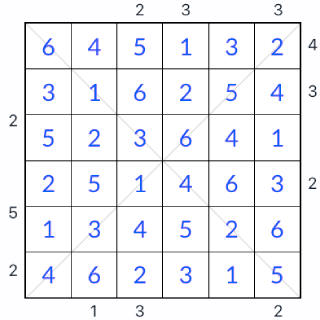Diagonal Consecutive Sudoku Easy
Like this puzzle!
5
4
3
6
3
9
1
5
2
4
3
6
1
8
6
2
4
9
8
3
3
9
8
6
6
9
5
4
7
5
2
1
4
9
4
5
6
1
2
3
4
5
6
7
8
9
?
~
123
1
2
3
Helping solve
Undo
Redo
Delete
0
Hint
Latest score list for #l2qnd
gu
guest a second ago
8'58''
an
anonymous 19 minutes ago
14'52''
In
Internet 20 minutes ago
12'30''
an
anonymous 51 minutes ago
9'2''
Pr
Prestashop 48 minutes ago
14'37''
gu
guest 57 minutes ago
11'34''
me
medical 58 minutes ago
5'54''
gu
guest 26 minutes ago
10'3''
gu
guest an hour ago
19'31''
Ur
Urgent 43 minutes ago
10'26''
Latest score list for Diagonal Consecutive Sudoku
se
semrush solved puzzle No#ge6rv;
9'27''
mo
motivation solved puzzle No#pwzjj;
18'50''
Ma
Mason solved puzzle No#9en9w;
19'34''
Em
Emma solved puzzle No#4wk7g;
18'50''
be
beauty solved puzzle No#j8914;
10'19''
Au
Automotive solved puzzle No#4wk7g;
18'47''
Bi
Bitcoin solved puzzle No#q84xe;
13'36''
gu
guest solved puzzle No#ge6rv;
17'7''
an
anonymous solved puzzle No#q84xe;
19'16''
ch
chocolate solved puzzle No#16gx0;
3'25''
How to play Diagonal Consecutive Sudoku
Diagonal Consecutive Sudoku Rules
Consecutive Sudoku: Standard Sudoku rules apply (1-9 in each row, column, and box) with the added twist of bars between some squares. These bars mean the numbers in those squares must be consecutive (differ by 1).
Diagonal Consecutive Sudoku Additional Rules:
-
Diagonal Sudoku Rule: Sudoku main diagonals also contain the digits 1 through 9.
Read more: Diagonal Consecutive Sudoku rule & tips
Using the Markings:
Pay close attention to the consecutive markers while placing numbers. If two cells are connected by a bar, the numbers you place in them must differ by exactly 1.
Conversely, if there's no marking between two cells, the numbers in those cells cannot be consecutive.
Diagonal Consecutive Sudoku = Diagonal Sudoku + Consecutive Sudoku.
Privacy Policy Copyright Gridpuzzle © 2024


























